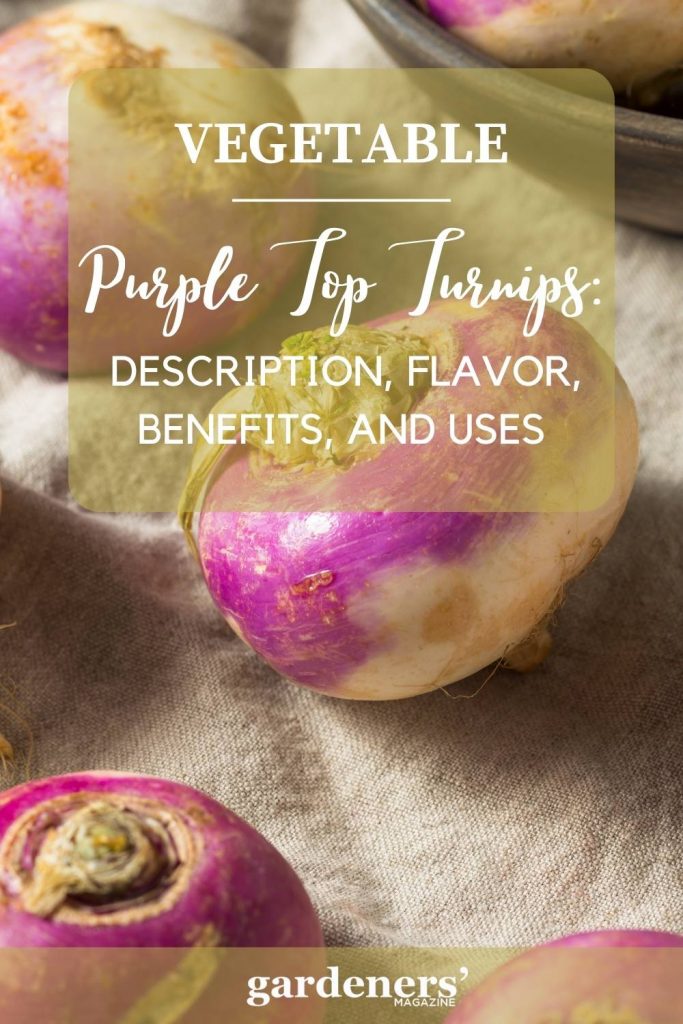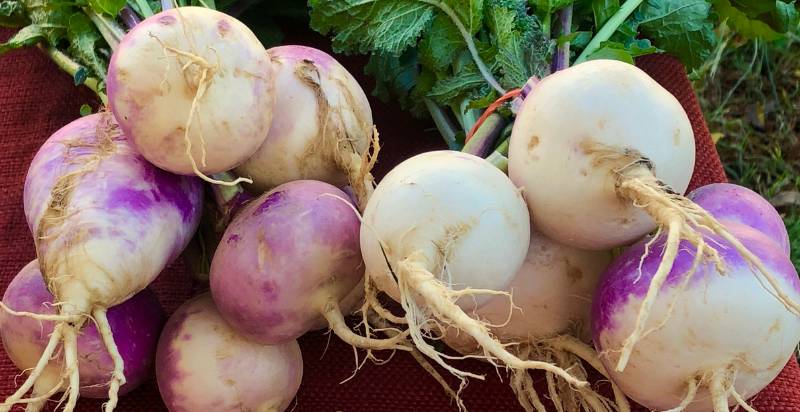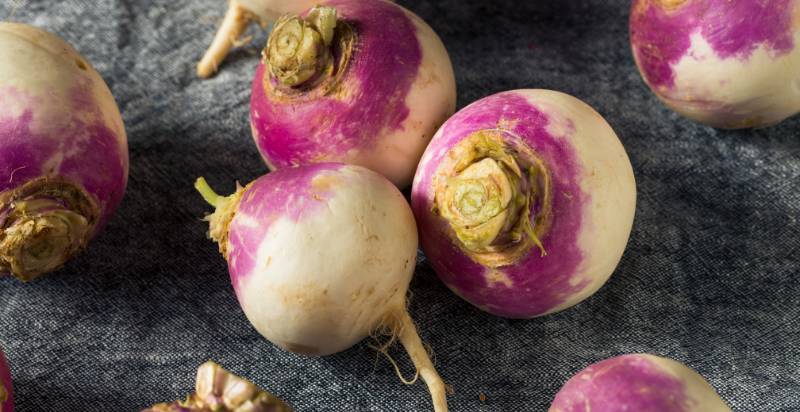Purple top turnips, or Brassica rapa, are root vegetables commonly grown in temperate regions worldwide for their edible taproots. They are a type of cruciferous vegetable related to broccoli, kale, and cauliflower, among others. These nutritious vegetables are a great addition to any garden or kitchen due to their easy cultivation, versatile flavor, and wealth of vitamins and minerals. This article discusses top purple turnips’ origins, cultivation, nutrition, and uses.
What are Purple Top Turnips?
Purple top turnips are a root vegetable related to the cabbage family. They have purple-tinted skin and white flesh with a slightly sweet, nutty flavor. The edible portion is called the “turnip top,” which can be eaten raw or cooked. Purple top turnips are often used in soups, stews, and salads. They can also be roasted, mashed, or pureed for various dishes.
Purple top turnips are an excellent source of Vitamin C and dietary fiber, making them a nutritious addition to any diet. They also contain significant amounts of calcium and potassium, important minerals for healthy bones. With their sweet flavor and crunchy texture, purple top turnips make a great snack on their own or as part of a larger meal.

History and Origin of Purple Top Turnips
The top purple turnip (Brassica rapa) is a root vegetable of European origin, first cultivated in the Mediterranean area. It was likely introduced from the Middle East around 1000 BC and then spread throughout Europe. The earliest known reference to the turnip comes from Homer’s Odyssey, which mentions it as an ingredient in a stew eaten by King Odysseus.
Purple top turnips were likely first grown in England during the Middle Ages, and by the 16th century, they had become a popular crop throughout England. It eventually spread to North America, becoming an important agricultural crop. Today, top purple turnips are grown worldwide for their edible roots as well as for livestock feed. The root can be eaten raw, steamed, boiled, or roasted.
Description of the Purple Top Turnips
Purple top turnips (Brassica rapa) are a cool-season root vegetable. They have a slightly sweet, nutty taste and a crisp texture. The bulbs are usually around three to four inches in diameter but can range from one inch to six inches, depending on the variety grown. The purple top refers to the reddish-purple color of the top of the root that is exposed when it’s harvested. The purple color fades as the turnip matures, usually leaving a creamy white bulb.
Flavor Profile of Purple Top Turnips
The flavor of Purple Top turnips is earthy and sweet, with a hint of bitterness. The root vegetable has a distinct nutty flavor that pairs well with other vegetables such as potatoes, carrots, celery, and onions. The texture of the turnip is still crunchy when cooked. It can be eaten raw in salads or lightly cooked in stews and soups. It can also be boiled, steamed, roasted, or mashed for a delicious side dish. Purple Top turnips are also a great addition to stir-fries and vegetable mixes. When paired with other flavors such as garlic, onion, and ginger, Purple Top turnips become even more flavorful.
Health Benefits of Purple Top Turnips
Purple Top turnips are a great source of dietary fiber, which is important for digestion. They also contain vitamins A and C, potassium, calcium, and iron. In addition, Purple Top turnips contain folate and beta-carotene that can help to support healthy vision. The high levels of magnesium found in the vegetable are important for building strong bones and reducing inflammation. Purple top turnips are low in calories and fat, making them a great food choice for weight loss or management.
Cultivation of the Purple Top Turnips
Purple top turnips should be planted in well-drained soil between 1 and 3 cm deep once seeds have germinated, thin out to about 10 – 15 cm apart for smaller varieties or around 20 – 30 cm apart for larger ones. For optimum growth and development, the soil pH should be kept at 6.0 – 7.5, and the soil should be fertilized with a balanced fertilizer before planting. Regular watering is also essential for the good size and quality of the roots.
To ensure success when growing Purple Top turnips, keeping weeds at bay to reduce competition for resources is important. It’s also important to keep the soil moist but not saturated. Applying a layer of mulch around the plants can help conserve soil moisture and reduce weeds. Purple Top turnips may benefit from light afternoon shade in regions with hot summers. You can enjoy a plentiful harvest of healthy and nutritious Purple Top turnips with proper care and cultivation.
Harvesting of the Purple Top Turnips
Harvesting of the Purple top turnips should begin when the root has reached a 5-7 cm diameter. Harvesting before this size will result in small, undesirable roots to sell. When harvesting, the turnip tops should be cut from the plant and discarded as they can be bitter. The leaves should also be removed from the root before storing or transporting them to market. Harvesting quickly and storing in a cool, dry area to prevent spoilage is important. Properly harvested and stored Purple top turnips can remain fresh for up to three weeks.
Purple Top turnip roots are typically graded according to size and quality before selling or using them in recipes. Smaller roots may be preferred for salads or dishes requiring dicing, while larger roots are often preferred for roasting. Choosing the appropriate variety of Purple top turnips for the desired use is important, as some varieties may be better suited to certain recipes or preparation methods.

Where Do Purple Top Turnips Grow?
Purple top turnips are a cool-season vegetable, which means they thrive in temperatures between 40°F and 75°F (4.4°C to 23.9°C). Generally, this root crop is well-suited for growth in most parts of the United States and Canada. Top purple turnips can be planted in the fall when winter temperatures get above freezing. Top purple turnips should be planted in early spring in regions where temperatures drop below freezing. This root crop thrives in Zones 3 to 8 (USDA Hardiness)
In the U.S., the top purple turnip is grown primarily in the northern Midwest and Central Plains states, including North Dakota, South Dakota, Minnesota, Wisconsin, and Iowa. It is also grown in areas of the Northeast, including New York, Pennsylvania, and New England states. In Canada, turnips are grown primarily in Ontario and Quebec.
What are the things you Need to Keep in Mind when Buying Purple Top Turnips?
- Consider the size of the turnip you are buying – Purple top turnips come in various sizes, so it’s important to make sure you buy one that suits your needs.
- Check the quality – Make sure you check the turnip’s quality before purchasing it, as this will help ensure its freshness and optimize its taste.
- Make sure the turnip is firm – Purple top turnips should be firm when you touch them, so give them a gentle squeeze before buying.
- Consider the price – Check for different stores and prices to get the best deal.
- Think of how you will use it – Are you planning to cook the turnip, or are you just looking for something to add color and flavor to your salad? Knowing what you will use the turnip for can help inform you which is right.
- Think about where it was sourced – Try to buy locally sourced Purple top turnips to help support local farmers.
- Look out for pests – Ensure the turnip is free from parasites or bugs before buying it. It’s also important to check for any signs of rot or mold, as this can affect the taste and freshness of the turnip.
These tips will help you get the best quality Purple top turnips for your needs.
What is the Best Way to Store Purple Top Turnips?
The best way to store Purple top turnips is in a cool, dry, and dark place. Ensure the temperature does not fall below 40 degrees Fahrenheit, which can cause the turnips to become soft and spoil quickly. The ideal top purple turnips storage temperature is 45-50 degrees Fahrenheit. They should also be stored away from direct sunlight and large heat sources.
It is ideal if you have a root cellar or other cool, dry place to store them. Keeping the turnips in plastic or cloth bags can help protect the roots from drying out. When stored properly, Purple top turnips should last 3-4 months. To maximize their freshness, regularly check for any signs of spoilage and remove any turning tops immediately.

How to Use Purple Top Turnips in Recipes with other Fruits and Vegetables?
Purple top turnips are versatile root vegetable that can be incorporated into many recipes. They have a mild flavor and delicate texture, making them ideal for pairing with other fruits and vegetables. A great way to use turnips in recipes is to roast them alongside potatoes, onions, carrots, and other root vegetables. This makes for a flavorful side dish or main course. Turnips can also be chopped and cooked in soups, stews, or braises for added flavor.
You can even bake turnips with apples for a sweet and savory combination. Purple top turnips also make a delicious addition to salads – grate them over your favorite greens and vegetables! With a bit of creativity, there are endless opportunities for adding these tasty root vegetables to your favorite recipes.
Conclusion
Purple top turnips are a great way to add delicious flavor and texture to your meals. Not only are they nutritious, but they also store well for extended periods. Following the guidelines mentioned above for storing Purple top turnips properly, you can enjoy their sweet taste and crunchy texture in recipe creations all year! So don’t be afraid to get creative with these versatile root vegetables – they will surely be a hit in your kitchen!
Thank you for reading this article on storing Purple top turnips – we hope it was informative and helpful.
- Everything You Wanted to Know About Red Tamarillos - June 2, 2025
- A Guide to Tulips: Everything You Need to Know & More… - June 2, 2025
- Guanabana: Description, Flavor, Benefits, And Uses - May 27, 2025

2 thoughts on “Purple Top Turnips: Description, Flavor, Benefits, And Uses”
Comments are closed.